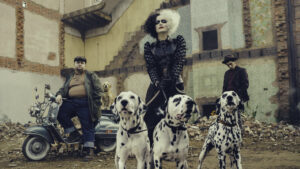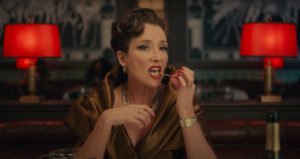Spring 2021 is the season of the heist genre, and there’s a little something for everyone depending on your taste. Craving magical crimes with a fantastical setting? Shadow And Bone will scratch that itch. Looking for gritty, action-packed heists with gory violence? Army Of The Dead will suit you well. Desiring something fun` and more than a tad bit campy, with fashion-forward antiheroes who come this close to openly embodying the queer anarchist rallying cry of “be gay, do crimes” without ever being explicitly queer because Disney is only feeling so generous with its rainbow capitalism on the eve of Pride Month? Yep, Cruella sounds like the movie for you.

Cruella is indeed a heist movie – as well as many other things – and that alone probably shouldn’t be surprising, given that the satanic style icon was stealing Dalmatian puppies all the way back in 1961. What is surprising is that Disney actually allows their protagonist to commit crimes unapologetically and often without provocation, even contemplating murder at one point. But for every police barricade Cruella De Vil (Emma Stone) jumps or barrels down in her automobile, there’s more set up further down the road that she won’t – literally can’t – cross. They’re the invisible but omnipresent barriers set up by Disney’s in-studio censors…a strict gridlock of moral guidelines that keep Cruella’s chaotic escapades from ever getting fully out of hand, i.e. beyond Disney’s ability to justify, excuse, or deem “family-friendly”.
Ironically, that means the one thing Cruella never does in this 101 Dalmatians origin story is skin puppies and make fabulous coats of their fur, which is…kind of her whole deal in the original movie. But there, she was a villain, so it really didn’t matter how many horrible things she did because her fate was determined from the outset by the Hays Code: she would be punished, and her crimes would all be undone. Sixty years later, the reverse is true – Cruella is a Disney protagonist now, so she can dabble in darkness but ultimately she will choose the morally “good” alternative to whatever evil deed seems easiest. She can contemplate murder now, which is progress, but she’ll resort to nonviolence in the end. She can joke about killing dogs, and the film can find a clever way to incorporate her inhumane fashion sensibilities into the story, but she’ll never actually do it.
And it’s a damn shame, because the screenwriters clearly want to push the limits of what they can do in a Disney movie. Cruella is a thief, a masterful one at that, and she keeps what she takes for herself – a stark contrast to Disney’s Aladdin. She vandalizes public property with glee. She outmaneuvers the police on a regular basis, and looks good doing it. There’s no reason why this version of the character, as distant as she may be from the iconic animated villain voiced by Betty Lou Gerson, couldn’t be legendary on her own. She could be another Kaz Brekker, to be honest: an ambitious antiheroine who manipulates the system that created her (in this case, the patriarchy) to get what she wants, while remaining fiercely protective of her found family.
There is of course the question of whether or not this needed to be a Cruella De Vil story at all, given how far it diverges from the source material, and the film…never really answers that question. It certainly does very little to offer any insight into Cruella as we remember her from 101 Dalmatians, so it’s not particularly effective as a prequel (despite the mid-credits sequel-bait scene that sets up the latter film’s events). But Cruella takes big liberties with the character, and isn’t afraid to pursue the consequences of those canon alterations. That’s how we end up spending a large part of the movie watching a glamorous, high-stakes battle of innovative fashion masterminds play out against the backdrop of late 70’s London: none of it has anything to do with Dalmatians, except tangentially, and every moment of it is glorious.

Cruella herself is a loud and proud punk rock fashion icon whom Emma Stone plays as if she just swaggered off the set of a Ryan Murphy Netflix show – and fans of those intoxicatingly campy and melodramatic shows, including Ratched and most recently Halston, will find much to love in Stone’s performance as well as many of her character’s story beats, from her sassy witticisms to the elegance she brings to all of her most outlandish costumes, whether riding in the back of a dump-truck with her train billowing out behind her in the street or staging a rock concert in a wealthy neighborhood and fleeing from the cops. Adding to the Murphyness of it all, Cruella finds Emma Thompson transforming into a narcissistic criminal mastermind named the Baroness Von Hellman, who owns a trio of attack dogs, a remote mansion equipped with cliffs off of which to push her rivals, and the undivided attention of the London tabloids.
But one thing this movie lacks entirely is explicit queer representation, a crucial ingredient in Murphy’s formula. Don’t get me wrong, the Hollywood trades made all the usual pre-release uproar about Disney’s nineteenth “first openly gay character” being a friend of Cruella’s named Artie (John McCrea), but this assumption seems to have been based on Artie wearing colorful, boldly patterned clothing…in the 1970’s. In one scene, he saves the life of Cruella’s henchman Horace (Paul Walter Hauser), and it’s deliberately vague enough that you can read as much or as little into that gesture as you want. Sure, I low-key ship it, but neither character is canonically gay – and it’s particularly disappointing given how easily this story could be viewed through a queer lens.
Among the supporting cast, there are several characters whose roles would presumably increase in a sequel, if one happens, although they’re currently rather underwritten. Kirby Howell-Baptiste’s Anita, in between being pressured to help one white woman’s rise to fame or threatened by another white woman to expose her rival’s secret identity, makes a strong argument for why she should lead the inevitable 101 Dalmatians remake. Kayvan Novak doesn’t leave quite as strong an impression as the hopelessly disorganized Roger, but he’s charming enough. There’s also a clever nod to the unnamed woman with the large shaggy dog who walks past Roger’s apartment in the opening scene of 101 Dalmatians, context which will no doubt prove vital when she appears in the remake.

To the film’s credit, it knows its core premise is an absurd attempt to exhume a decades-old franchise, and it absolutely revels in that knowledge – because why not? It’s about time Disney’s live-action remakes started having fun with the rich source material: enough of the halfhearted meandering (Beauty & The Beast), the low-quality photocopies (The Lion King), and the bland, uninspiring war-epic (Mulan); in with the ornate, outlandish, camp masterpiece. Not that it will satisfy some people, who have already taken a key scene from the first act and distributed it online as evidence that the film is an atrocity, as if that scene was not very clearly intended to be shockingly bizarre. If anything, people should be upset that the film doesn’t go far enough! But to quote Artie, “‘Normal’ is the cruelest insult of them all, and at least I don’t get that”.
Rating: 8/10